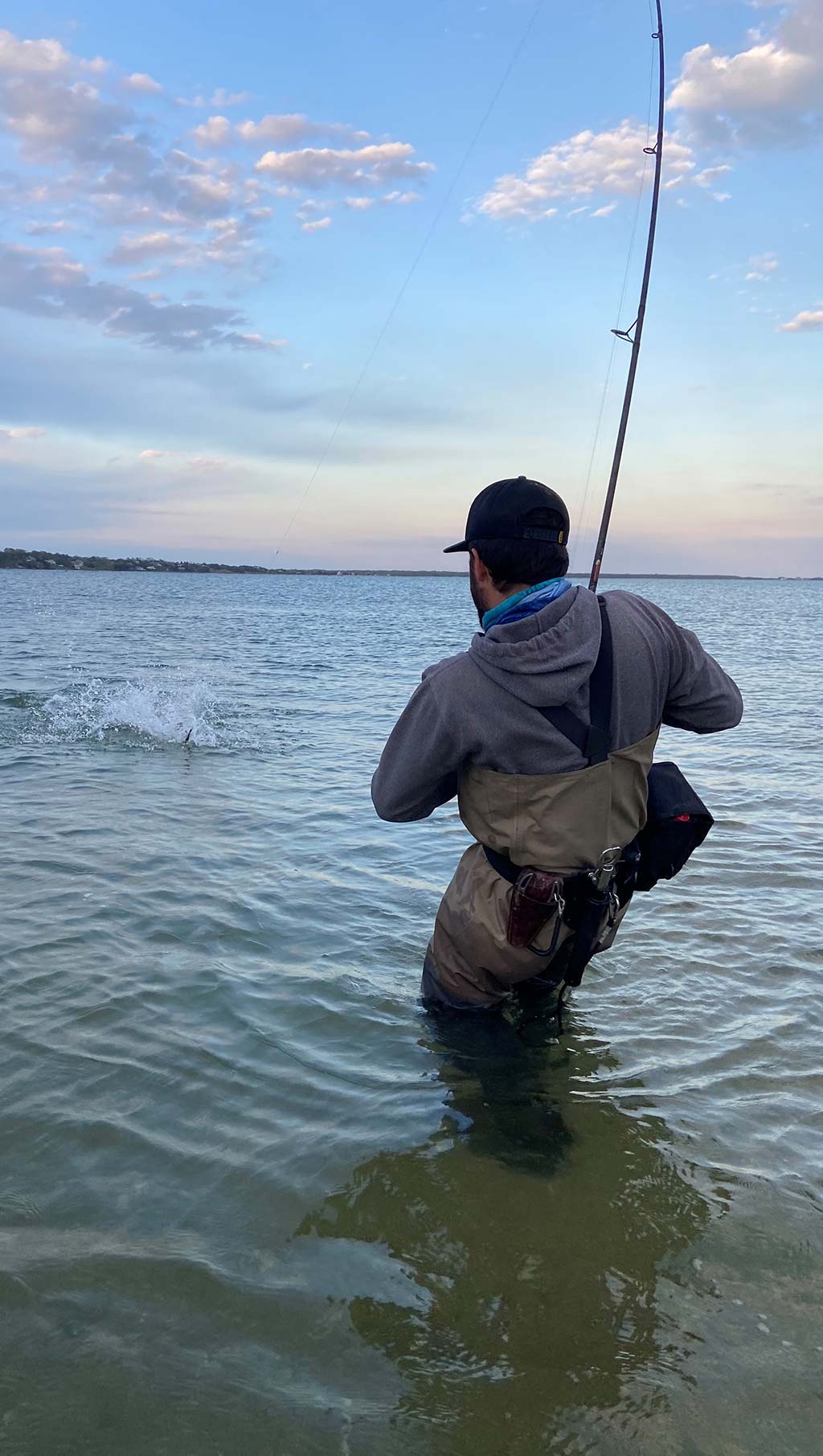
The ultimate reward in fishing topwater plugs is when a 30 or better striper rises from the depths to crash your offering.
Wherever you cast for stripers and blues along the Striper Coast, there is no better way to catch them than on surface lures. It may not be the most productive approach at times, but having a 20 or 30-pound striper or a teen-size blue explode on a topwater plug is tough to beat. There are other artificials that are easier to fish effectively, but for those who take the time to learn how to work the various topwater offerings, the rewards are worth the effort.
Over the years, whether it be at seminars, shows or while guiding clients in the surf, the most commonly asked question was not where to go, or how to read a beach, but how to work a plug in the surf. It shouldn’t be that surprising when you consider how confusing it must be for a newcomer to surf fishing when confronted by a wall of mysterious looking creations in their local tackle shop. The best advice is to narrow down the choices to a handful of plugs that will allow you to cover a variety of fishing conditions, and then become proficient at working them. Once you develop confidence in those lures, you can begin to expand your arsenal. Having confidence in what is on the end of your line will have a lot to do with how successful you become at the plugging game.
Standard Poppers
For the sake of categorizing, we’re talking about those plugs with a concave head. Body shapes can vary greatly, but all can be worked in a similar fashion. For the most part, stripers are lazy and do not like to expend a lot of energy chasing down a meal. This is especially true of big bass. Even big bluefish sometimes prefer a slower worked offering.
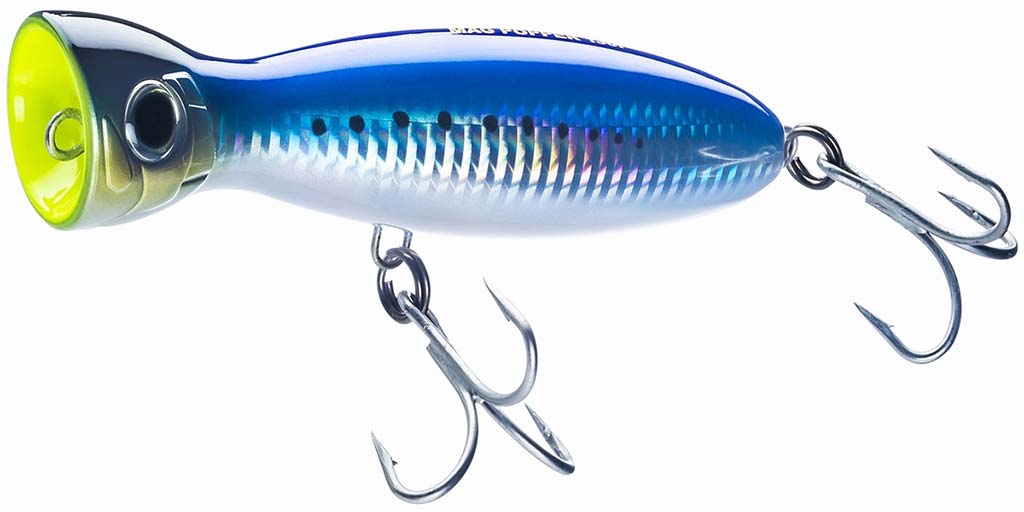 The trick to working a popper slowly on the surface lies in getting to know your plugs and developing a rhythm. Plugs that float are obviously much easier to work on the surface, while some sinking plugs require considerable effort to keep them on top. Get familiar with the plugs in your arsenal during down time when there are no fish around, or take them down to a local dock and experiment with your retrieve there.
The trick to working a popper slowly on the surface lies in getting to know your plugs and developing a rhythm. Plugs that float are obviously much easier to work on the surface, while some sinking plugs require considerable effort to keep them on top. Get familiar with the plugs in your arsenal during down time when there are no fish around, or take them down to a local dock and experiment with your retrieve there.
You should not have to jerk hard to make a plug “pop.” Moving your wrist and forearm a half foot or so is all it should take under most calm water conditions. I prefer parabolic action rods with some stiffness in the tip. As a result, it requires little effort to make a plug move, compared to using a rod with a softer fast tip action. All you are trying to do is get the head of the plug to push enough water to create the fish attracting pop. Popping the plug too hard will cause the entire lure to come out of the water and render it ineffective.
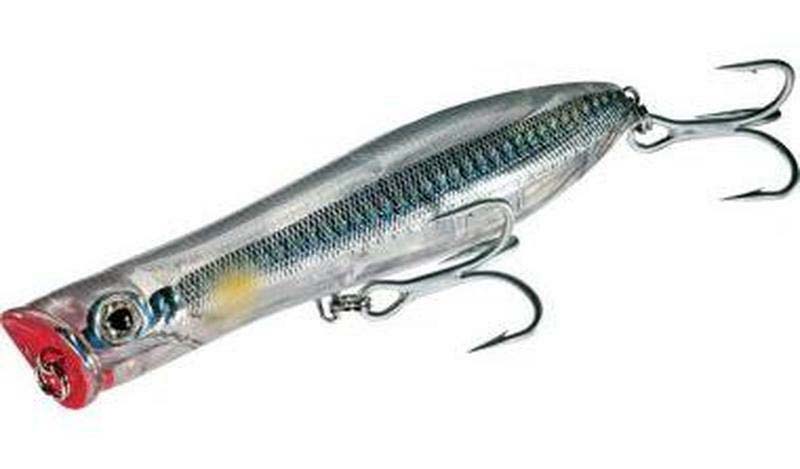 It’s important to always maintain contact with your lure, and have the rod in position to set the hook when a fish comes calling. Keeping the rod between 2:00 and 1:00 should give you enough room to work the lure and still be in position to set the hook. When you do raise a fish, resist the urge to set the hook at the sight of the fish hitting the plug. Give a slight pause and hold off striking until you feel resistance or the weight of the fish. This holds true when fishing with any surface plug.
It’s important to always maintain contact with your lure, and have the rod in position to set the hook when a fish comes calling. Keeping the rod between 2:00 and 1:00 should give you enough room to work the lure and still be in position to set the hook. When you do raise a fish, resist the urge to set the hook at the sight of the fish hitting the plug. Give a slight pause and hold off striking until you feel resistance or the weight of the fish. This holds true when fishing with any surface plug.
As exciting as it can be to catch fish on poppers, if you are only using these plugs in the standard modus operandi, than you are shortchanging the fish-catching ability of these lures. Poppers have long been tagged with being a daytime lure, and as such you’ll find very few casters who store poppers in their “night bag” unless they plan on fishing through the night and into dawn before ending their shift. Yet, poppers can be a very effective tool, even after the sun goes down.
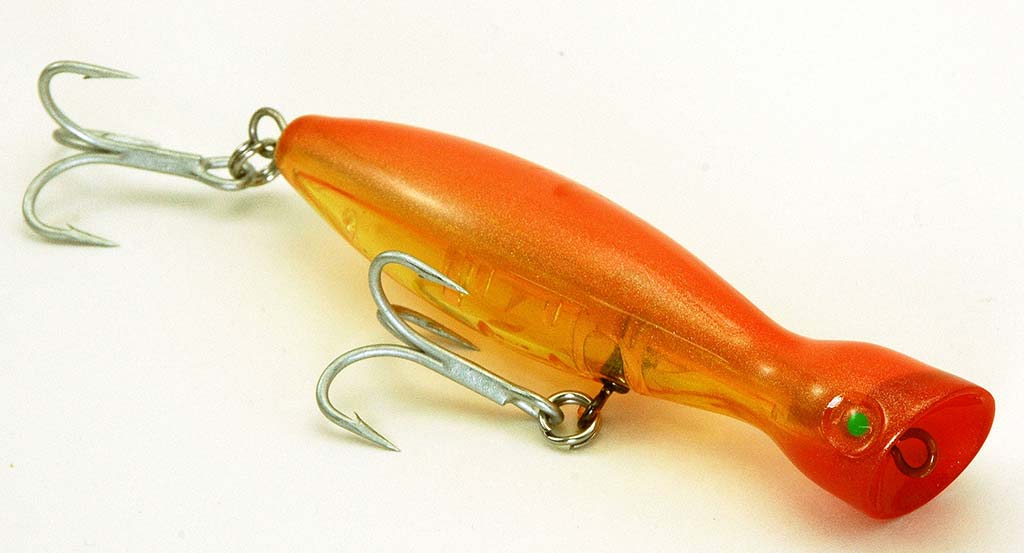 One plug that has proven very effective at night has been the 2-3/8 ounce Super Strike Little Neck Popper. When retrieved at a very slow pace, you can feel the plug working, much like a metal lip swimmer. However, perhaps the real key to its success is the ability to cast these plugs further than the much more popular darter, especially when wind is a factor. There are nights – and days – when that extra casting distance can spell the difference between drawing blanks and leaving the beach smiling.
One plug that has proven very effective at night has been the 2-3/8 ounce Super Strike Little Neck Popper. When retrieved at a very slow pace, you can feel the plug working, much like a metal lip swimmer. However, perhaps the real key to its success is the ability to cast these plugs further than the much more popular darter, especially when wind is a factor. There are nights – and days – when that extra casting distance can spell the difference between drawing blanks and leaving the beach smiling.
If you plan on adding a couple of these poppers to your night bag, the preferred approach is to remove both sets of 2/0 trebles and replace the belly hook with a 3/0 or 4/0 VMC treble.
Another option that poppers provide is that they can be very effective at doubling as surface swimmers in daylight conditions. Both the Gibbs Polaris and the Super Strike Little Neck, when retrieved very slowly along the surface, will “swim” much like a surface swimming metal lip. Both have accounted for their share of stripers when fished in this manner, but some standard type poppers can also be induced to swim, once you figure out the right rate of retrieve.
Pencil Poppers
If you tremble at the sight of a big striper crashing the surface and pouncing on a topwater plug, you’ve got to love pencil poppers. There is no more explosive strike than when a big striper is annoyed enough at the commotion created by these plugs to want to eliminate it from existence. I’ve been fortunate to beach a number of 40-pound class stripers on these plugs over the years, and the strike of every one of them has left an indelible mark. Add to those the strikes of fish that failed to stay connected, the result of ripped out swivels and through wires, or straightened hooks. Then there are those that simply missed my hooks.
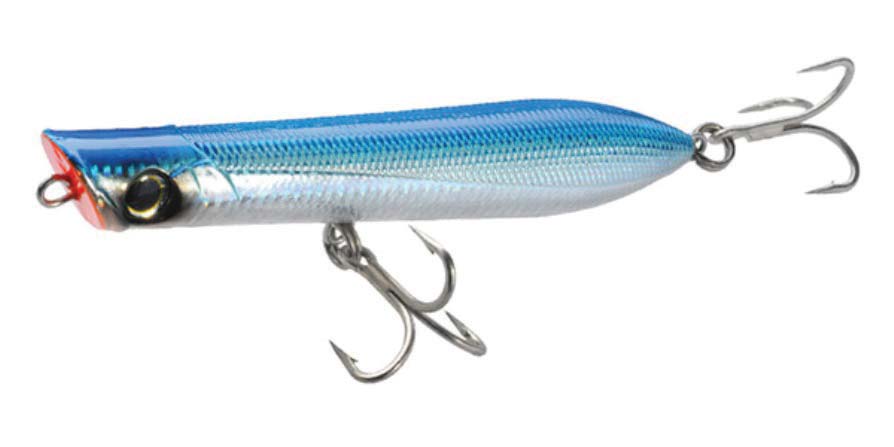 And while the strike itself is enough to fold a weak heart, there are those surface antics once they feel the steel, sometimes cartwheeling, sometimes headshaking with gills flared – much like a tarpon, always thrashing wildly on the surface for those first few seconds of the battle. All of this, along with them being so damn effective on bass and blues of all sizes, and you can understand my love affair with these plugs.
And while the strike itself is enough to fold a weak heart, there are those surface antics once they feel the steel, sometimes cartwheeling, sometimes headshaking with gills flared – much like a tarpon, always thrashing wildly on the surface for those first few seconds of the battle. All of this, along with them being so damn effective on bass and blues of all sizes, and you can understand my love affair with these plugs.
For many years there was a general belief that it required rods with a specific action to make the plug dance properly. In fact, some of the more parabolic Lamiglas blanks were ideal for working the Gibb’s pencils, which for many years were the only choice besides those being turned out in basements and garages. In fact, today’s graphite and composite blanks combined with braided lines make it easier to work the plug properly. With no give or stretch in the line, and rods weighing a fraction of what they did a decade ago, it takes considerably less effort to make a pencil popper dance effectively.
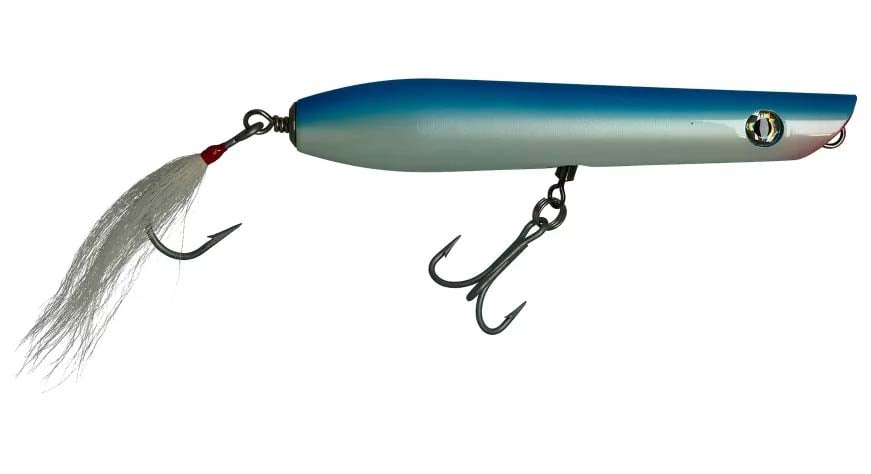 There are numerous choices hanging from the walls of local tackle shops. I’d suggest trying one or two at a time and see which model allows you to make the longest casts, yet provide you with the right action. Your rod and your method of working the plug might be more compatible with certain models.
There are numerous choices hanging from the walls of local tackle shops. I’d suggest trying one or two at a time and see which model allows you to make the longest casts, yet provide you with the right action. Your rod and your method of working the plug might be more compatible with certain models.
The head of the plug should slap up and down, and side to side when worked properly. That is accomplished by sliding your right hand a comfortable arms length up the blank (provided you are right-handed). Wrap your hand around the rod and hold the line between your thumb and first finger to create tension during the retrieve. If you don’t do this, your line will spool in loose coils and you are destined for wind loop city. As you slowly retrieve the plug, pump or push the rod with your right hand. If the plug stops working properly, take a couple of quick turns on the reel to pick up the slack. With a little practice, you will be able to pause your retrieve and let the plug do its crazy dance without moving forward – a tactic that drives bass nuts. The plug’s ability to raise fish when other topwaters fail is well documented, and reason enough to add a couple to your arsenal.
Spooks
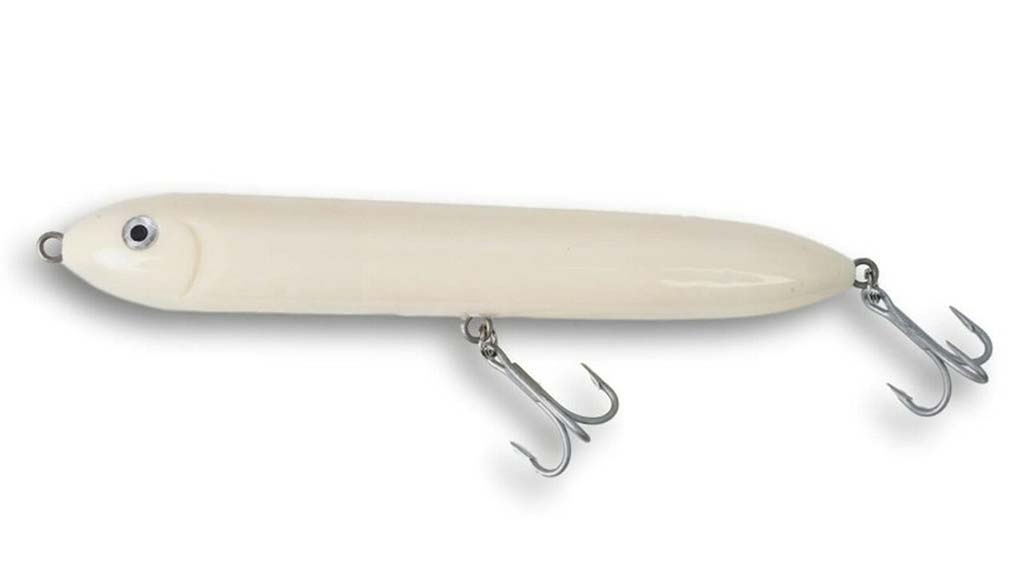 Spook style plugs are another topwater lure that has the ability to draw dramatic surface strikes from stripers and blues. Their popularity with saltwater anglers, especially the surf crowd, has grown considerably in recent years. The Zara Spook has long been a tool of musky and largemouth bass anglers, but an increasing number of casters have discovered the effectiveness of the lure’s tantalizing back and forth action on saltwater gamefish over the past decade. The development of models geared to the salt have also added to the growing use of these plugs.
Spook style plugs are another topwater lure that has the ability to draw dramatic surface strikes from stripers and blues. Their popularity with saltwater anglers, especially the surf crowd, has grown considerably in recent years. The Zara Spook has long been a tool of musky and largemouth bass anglers, but an increasing number of casters have discovered the effectiveness of the lure’s tantalizing back and forth action on saltwater gamefish over the past decade. The development of models geared to the salt have also added to the growing use of these plugs.
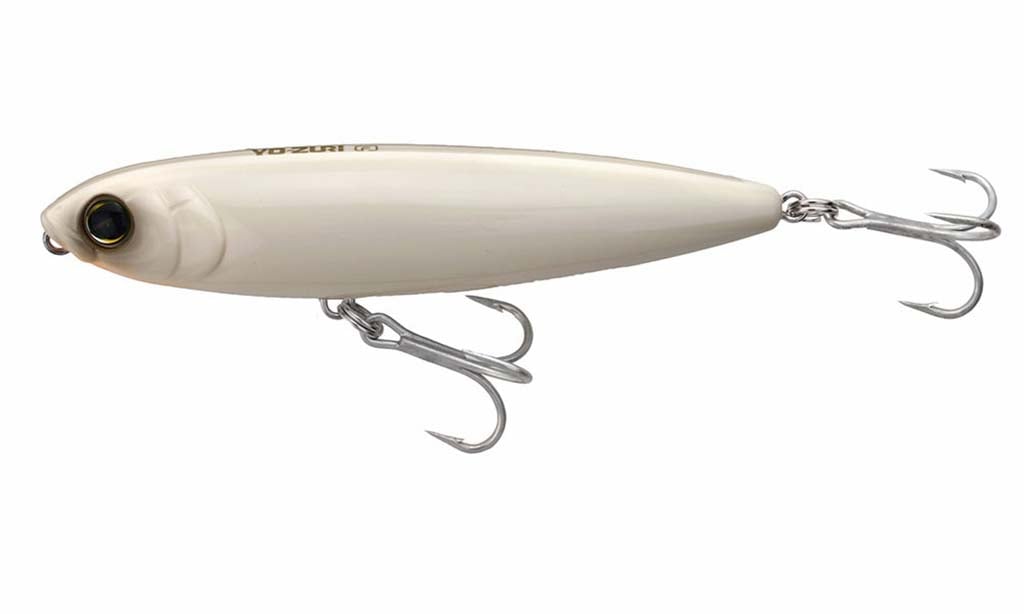 The preferred way to work a spook is with short, side-to-side, downward jerks with the rod tip pointed down toward the water. That works fine in a boat and in some shore situations, but for most surf fishing situations, holding the rod at your side and parallel to the water is a better option. Short jerks with brief pauses will generate the side-to-side action that induces strikes, even when stripers or blues are not in full feeding mode. I have seen several instances where standard poppers would not draw a strike, while spooks were being slammed. Some casters prefer to point their rod up at a 45-degree angle and pop the plug, similar to working a standard popper. The bottom line is if you can get the desired action from the plug, select the method that is most comfortable for you.
The preferred way to work a spook is with short, side-to-side, downward jerks with the rod tip pointed down toward the water. That works fine in a boat and in some shore situations, but for most surf fishing situations, holding the rod at your side and parallel to the water is a better option. Short jerks with brief pauses will generate the side-to-side action that induces strikes, even when stripers or blues are not in full feeding mode. I have seen several instances where standard poppers would not draw a strike, while spooks were being slammed. Some casters prefer to point their rod up at a 45-degree angle and pop the plug, similar to working a standard popper. The bottom line is if you can get the desired action from the plug, select the method that is most comfortable for you.
Two of the most popular models with surfcasters are the DOC Spook and the Mully Spook made by 24/7 Lures. The DOC is available in a 9-inch, 3.25-ounce and 7-inch, 2.75-ounce models. The Mully Spook measures 7 inches and weighs 2.75 ounces.
Metal Lips
Overlooked by many casters, these plugs, especially in larger sizes, have a knack for producing quality stripers and blues. Although they can be made to fish on or below the surface, and some models are designed to run well below, my first choice is to swim them on the surface. When worked properly, that seductive, tantalizing side to side wiggle can drive stripers and big blues crazy, as evidenced by the explosive strikes that often occur when a fish decides it’s had enough and tries to eat your wood or plastic imposter.
Long standing favorites like the Gibb’s Danny, Jr. Atom and Atom 40 are readily available, along with numerous other custom-made designs. Some, you will find on tackle shop walls, while classics like original Dannys, especially those made by Dan Pinchney and Super Strike’s Don Musso (the original designer of the Danny Plug), and Bob Hahn’s plugs can sometimes be found at garage sales, flea markets or bought from some retiring long time surfmen. The six to eight-inch models get most of my attention, and tend to draw the largest fish. They also have the ability to draw fish up from 20 feet of water or more thanks to their larger profile and the surface disturbance caused by their swimming action.
When it comes to matching the hatch, these plugs make obvious sense when fish are feeding on bunker, herring, shad, mackerel, small bluefish and a host of other large baitfish. However, don’t overlook going to the other extreme. I’ve had success a number of times by turning to one of these large plugs when bass were being especially finicky as they fed on tiny white bait or baby sand eels. Most times it resulted in just hooking two or three fish, but they were often the only fish taken among a small group of casters.
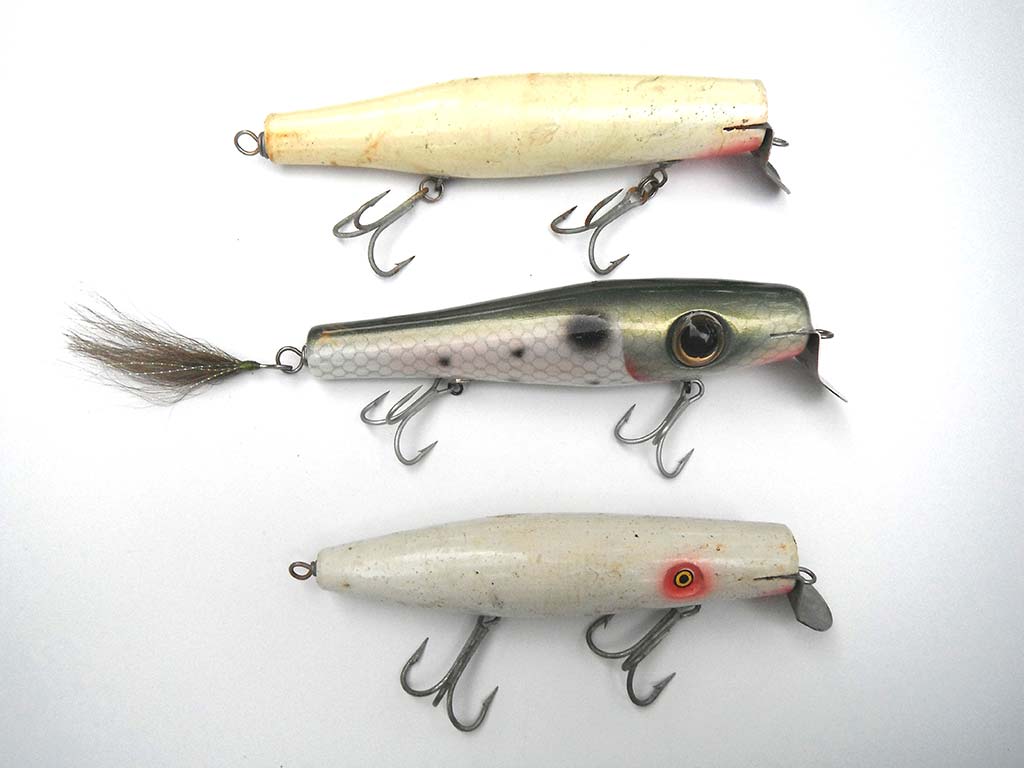
Adjusting the plug to swim on the surface is accomplished by using a pair of pliers to bend the eye of the plug in the opposite direction you want it to swim. Bend it down to make it swim higher on the surface, and up to make it swim below the surface. Try to avoid messing with the plug’s lip unless the lure is not swimming properly to begin with, in which case you have nothing to lose.
I prefer a plug with a nice side-to-side kick that leaves a very noticeable wake.
To allow for better side-to-side movement at a slower rate of retrieve, I often remove the tail hook from these plugs. You will miss few, if any, strikes from bass since they will almost always take these lures head first. When white bait is in evidence, adding a small tuft of hookless bucktail to the tail will often result in more strikes, a point frequently driven home by master plug builder Don Musso.
When fished on the surface, you must maintain constant contact with the plug and adjust your retrieve accordingly in order to get just the right swimming action throughout the retrieve. You will need to make adjustments as the lure swings in the current and as your lure is slowed or speeded up by wave movement.
Metal lips do not cast well. It is their lack of castability compared to other surface plugs that make some casters shy away from these lures. When casting these plugs, I like to finger my line as the plug is descending, allowing it to slap the surface as it lands. That slapping sound seems to draw the attention of cruising stripers, especially in clam water, and will sometimes illicit a strike as soon as the plug hits the water. Letting the plug sit for several seconds and giving it a hard pop before beginning your retrieve, will draw a strike at times.
I have read where these plugs are not effective in calm water. In fact, just the opposite is true, and I have caught scores of big stripers in calm water conditions to drive this point home. The drawing ability of these plugs is enhanced by a calm surface, although a slight chop that doesn’t impact on the plug’s action can help mask the imposter. Another ideal situation is when you have a decent surf running but the surface is calm. Under these conditions, time your casts so that you can work the backside of incoming waves. This is especially effective when you can present your plug from a jetty or other structure that parallels the waves, a situation most often found on the ocean side of jetty pockets.
The ultimate reward in fishing topwater plugs is when a 30 or better striper rises from the depths to crash your offering, setting off a shower of spray and some wild surface antics. Have this happen once, and you will be hooked.




